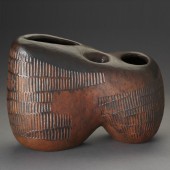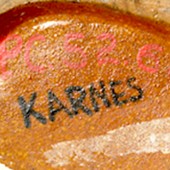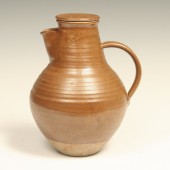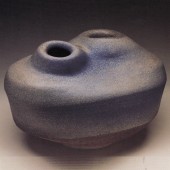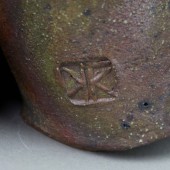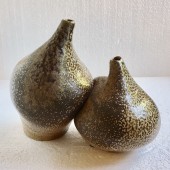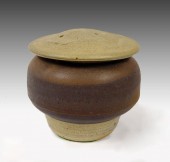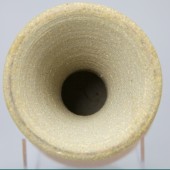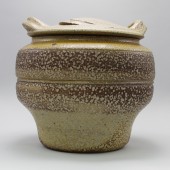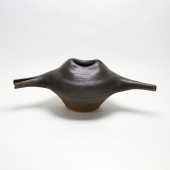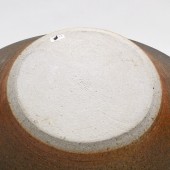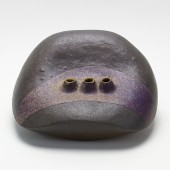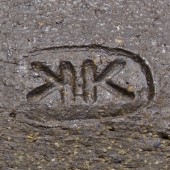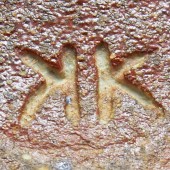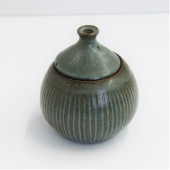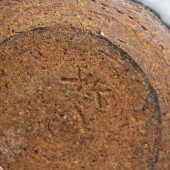![]() Printer version
Printer version
Karen Karnes
1925 Born New York, New York
2016 Died Morgan, Vermont
EDUCATION
1946BA Brooklyn College, Brooklyn, New York
1951-1952Graduate Fellow, New York State College of Ceramics, Alfred University, Alfred, New York
PRIMARY WORK EXPERIENCE
1954-1979Gate Hill Cooperative, Stony Point, New York
1967Faculty, Penland School of Craft, Penland, North Carolina
APPRENTICESHIPS AND RESIDENCIES
1949-1950Independent Study, Sesto Fiorentino, Italy
1952-1954Potter in Residence, Black Mountain College, Asheville, North Carolina
BIOGRAPHY
Karen Karnes is known for wheel-thrown functional pottery, especially her iconic covered casseroles and her experiments with wood firing both functional and sculptural pottery.
Early in her career Karnes worked with molds and fired work in an oil-fueled kiln. It was during Karnes’ time in Italy that she learned to work with a potter’s wheel. Returning to the US, she studied at the New York State College of Ceramics at Alfred University. In 1952 she and her then husband, David Weinrib, were potters-in-residence at Black Mountain College where they remained until 1954. They were present for the series of seminal ceramics symposia bringing together Soetsu Yanagi, Shoji Hamada, Bernard Leach, with Marguerite Wildenhain as the moderator. Attended by makers and ceramics educators, these symposia had a far-reaching effect on the making and firing of pots in the United States.
In 1954 Karnes and her husband moved to Stony Point, New York where they worked with other potters to develop the Gate Hill Cooperative. During this period Karnes concentrated on the production of multiples, functional pottery, and developed her iconic flame ware casseroles. These sturdy walled vessels were thrown with deep finger ridges that hold the glaze to create a two-tone appearance. They were finished with a pulled and folded or open loop lid handle attached at an angle. The natural rhythm of the lid handle retained the sense of plasticity of the clay. The casseroles are an example of Karnes’ respect for ceramic traditions with a modern approach.
While teaching at Penland in 1967 she began to use salt in her firings, something she would continue to do throughout her career. After returning to Gate Hill she built a salt kiln there with the help of her friend Mikhail Zakin, also a potter. Karnes moved to Vermont in 1979 where, after producing primarily functional work for many years, she created a series of sculptural pieces that referenced functional forms. She continued to explore atmospheric effects of wood and salt firing and their results on the finished ceramic surface. She stopped firing her own kiln after 1998 when a fire destroyed her kiln shed and home. Subsequently, her pieces were fired in the wood-fueled kilns of fellow potters around New England.
Karnes’ later work consists of sculptural objects of manipulated thrown pots transformed into objects unrelated to their original components or utility.
An interview with Karen Karnes conducted August 9, 2005, by Mark Shapiro for the Archives of American Art's Nanette L. Laitman Documentation Project for Craft and Decorative Arts in America is available at:
http://www.aaa.si.edu/collections/interviews/oral-history-interview-karen-karnes-12096.
PUBLIC COLLECTIONS
Alfred Ceramic Art Museum, Alfred University, Alfred, New York
American Museum of Ceramic Art, Pomona, California
Arizona State University Art Museum, Pheonix, Arizona
Aukland Museum, Aukland, New Zealand
Bemidji State University Collection, Bemidji, Minnesota
Brunnier Art Museum, Iowa State University, Ames, Iowa
Canton Museum of Art, Canton, Ohio
Cranbrook Academy Museum of Art, Bloomfield Hills, Michigan
Currier Museum of Art, Manchester, New Hampshire
Delaware Museum of Art, Wilmington, Delaware
Detroit Institute of Art, Detroit, Michigan
Everson Museum of Art, Syracuse, New York
Honolulu Museum of Art, Honolulu, Hawaii
Los Angeles County Museum of Art (LAMCA), Los Angeles, California
Manchester Craftsmen's Guild, Pittsburgh, Pennsylvania
Metropolitan Museum of Art, New York, New York
Mint Museum, Charlotte, North Carolina
Museum of Arts and Design, New York, New York
Museum of Fine Arts, Boston, Massachusetts
Museum of World Folk Art, La Jolla, California
Nelson Fine Arts Center, Arizona State University, Tempe, Arizona
Northern Clay Center, Minneapolis, Minnesota
Palmer Museum of Art, Pennsylvania State University, University Park, Pennsylvania
Philadelphia Museum of Art, Philadelphia, Pennsylvania
Racine Art Museum, Racine, Wisonsin
Southern Highland Craft Guild, Asheville, North Carolina
Smithsonian American Art Museum, Renwick Gallery, Washington, D.C.
St. Louis Museum of Art, St. Louis, Missouri
Topeka Public Library, Topeka, Kansas
Victoria and Albert Museum, London, England
Weisman Art Museum, University of Minesota, Minneapolis, Minnesota
Wichita Center for the Arts, Wichita, Kansas
BIBLIOGRAPHY
Boylen, Michael. "A Karen Karnes Workshop." Ceramics Monthly, 1981.
Clark, Garth, and Margie Hughto. A Century of Ceramics in the United States 1878-1978. New York, NY: E.P. Dutton, 1979.
Dietz, Paula. "American Pottery." New York Times Home Design, April 13, 1986
Hynes, Reggie. "Karen Karnes Workshop." Ceramic Review, May/ June 1982.
____________. "Karen Karnes Retrospective." Ceramics Monthly, March 1978.
____________. "Karen Karnes," Ceramic Review, March/April 1978.
Levin, Elaine. The History of American Ceramics From Pipkins and Bean Pots to Contemporary Forms, 1607 to the Present. New York, NY: Harry N. Abrams, Inc., 1998.
Lynn, Martha Drexler. Clay Today Contemporary Ceramists and Their Work A Catalogue of the Howard and Gwen Laurie Smits Collection at the Los Angeles County Art Museum. Los Angeles, CA: Chronicle Books, 1990.
Rubin, Michael. "Karen Karnes." Ceramics Monthly, April 1986.
Shapiro, Mark ed. Chosen Path: The Ceramic Art of Karen Karnes. Chapel Hill, NC: The University of North Carolina Press, 2010.
Silberman, Robert. “Modernism As It Was Meant To Be.” American Craft, April/May 2011.
Smith, Dido. "Karen Karnes.” Craft Horizons, May/June 1958.
CV or RESUME: Click Here to Download
Source: Lacoste Gallery
 | Southern Highland Craft Guild |
 | Center For Craft |
 | AMOCA American Museum of Ceramic Art |
"KARNES" on early work, ca 1951; after that, "KK", with first "K" reversed. Some flameware pots have "Flameware" stamped after mark.
Materials: Stoneware
Method: Thrown and Altered
Surface Technique: Salt Fired, Woodfire
Citation: "The Marks Project." Last modified February 17, 2025. http://www.themarksproject.org:443/marks/karnes









